A new generation of fox hunters is hoping to save the controversial sport
Fox hunting in America has withstood the Civil War, two industrial revolutions, the Great Depression and suburban sprawl. But can it survive much longer into the 21st century?
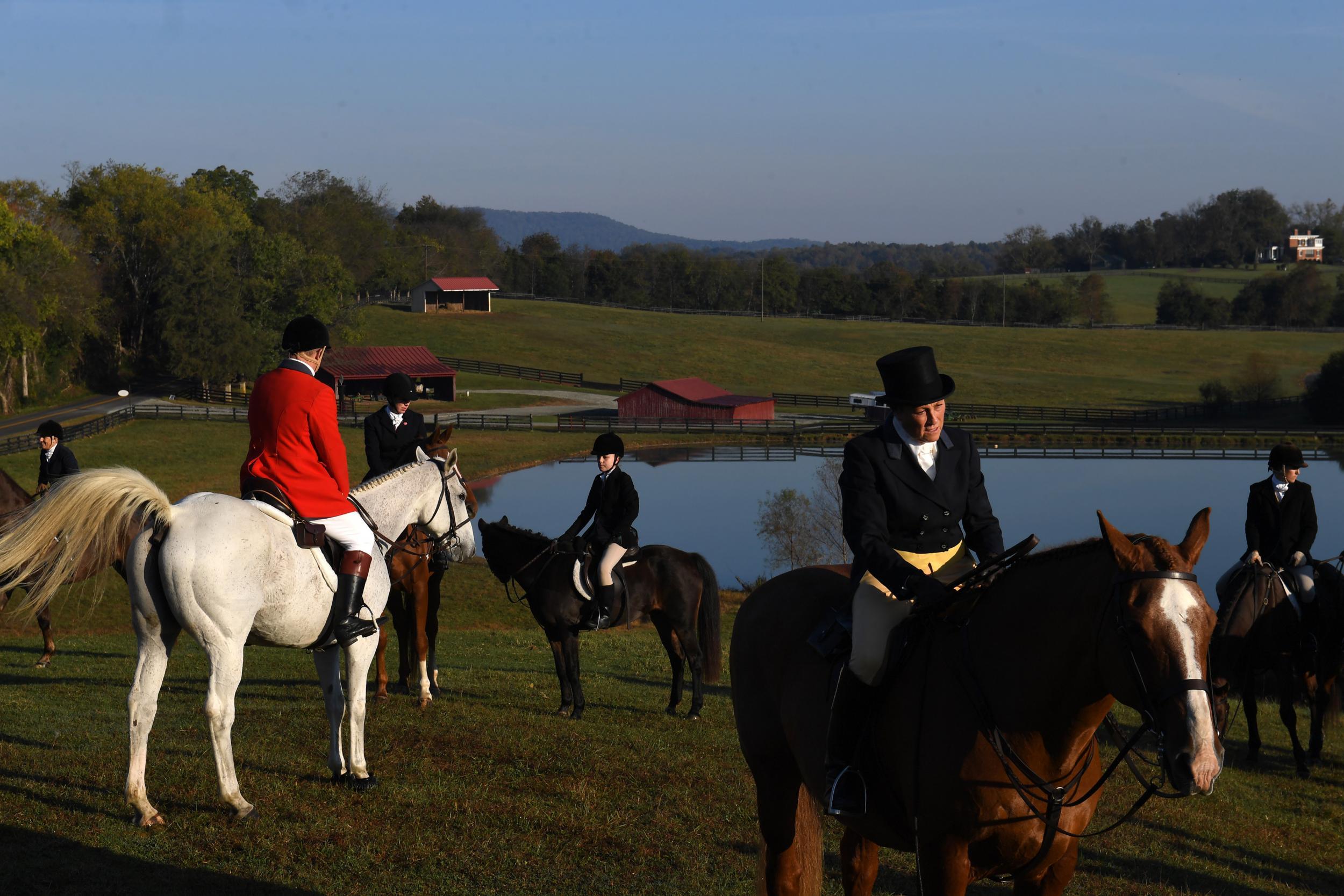
They assemble on a barren, wintry field in Poolesville, Maryland, near a bend in Dry Seneca Creek. It’s an exceptionally windy morning in mid-December, and only a few hunt members show up, horses in tow, to participate in the day’s expedition. Far more numerous are the foxhounds: some three dozen in all, running and sunning their flanks as they await further instructions.
“Let’s go hunting!” cries Brian Kiely, lately of County Waterford, Ireland, and currently a professional fox hunter for the Potomac Hunt Club. He is also a champion hunt caller, which means he can manipulate the brass hunting horn he carries with remarkable precision. Throughout the hunt, Kiely switches between sweet notes (to urge his hounds on) and sour tones (to pull them back). He begins the morning by casting the hounds into a nearby covert – the heavy brush where small animals take cover. When one hound finally picks up the scent of its quarry, it lets out an excited yelp and the field converges to join. The fox makes a break for open pasture. The chase is on.
For the next two hours, Kiely alternately scatters his pack apart and draws it back together – the former to root out traces of a fox hidden somewhere in a large stretch of land, the latter to pursue the quarry cross-country. The riders do their best to keep up with the onrushing hounds: crossing streams, galloping through pastures and jumping fences. As the hunt races forward, three species became a single herd, all in pursuit of a nimble, if unwilling, foe.
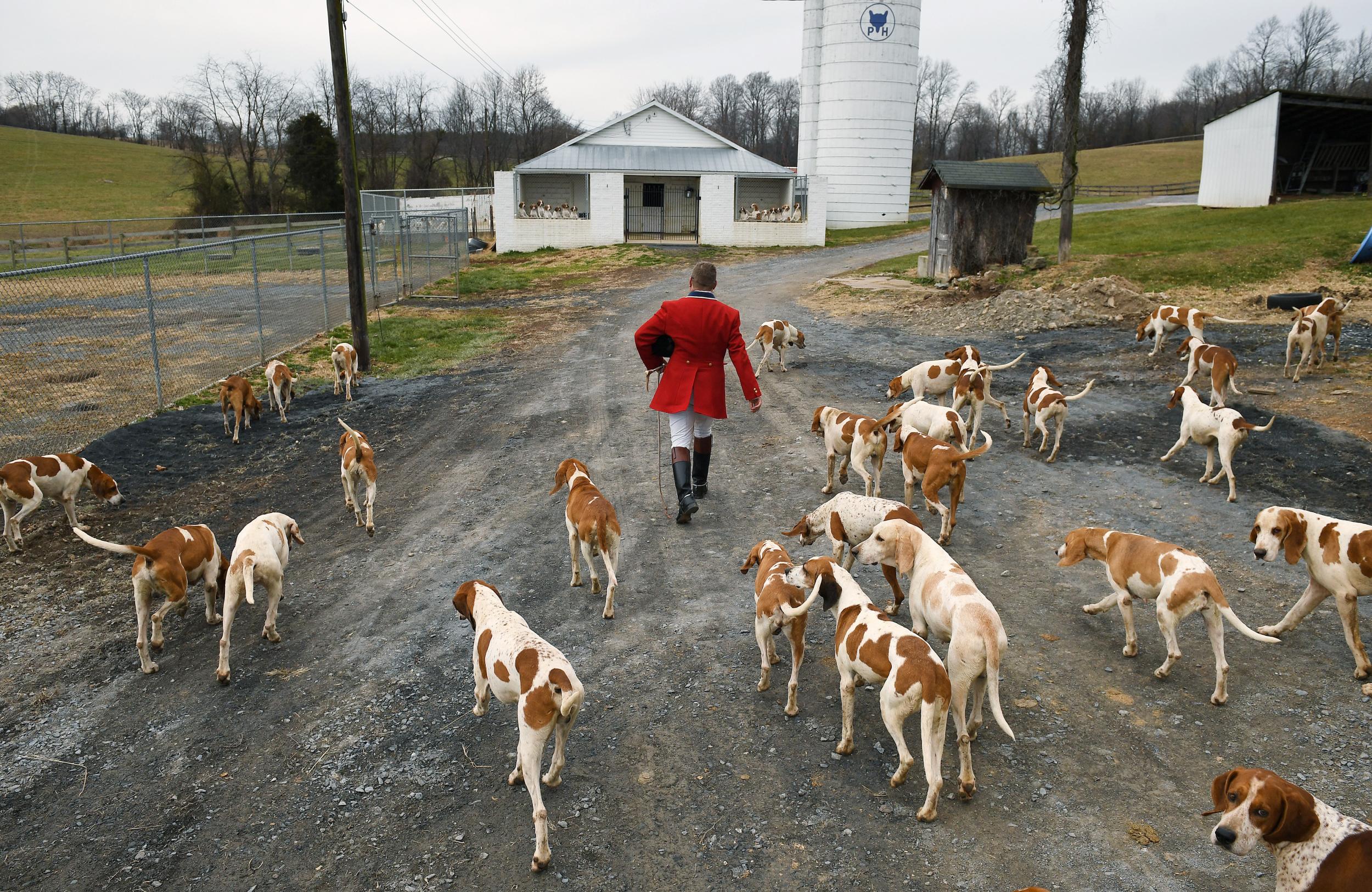
For Sir Roger Scruton – author On Hunting, in defence of the sport, who settled for a time in the Washington area just for the fox hunting – this union of species is key to explaining the thrill of the chase. The joy, he writes, “comes from sharing in the animal excitement, so that the currents of emotion which flow from hound to horse and back again are diverted through your pumping arteries, dissolving human knowledge and spreading it to the centaur limbs below”.
Today, in the United States, the hunt typically ends once the fox burrows itself into the earth. And yet, even though the fox usually survives, the idea of chasing a small woodland creature for fun has inevitably come into conflict with modern notions of animal rights. Protests happen often enough that the Masters of Foxhounds Association of America has a guide to managing them. Meanwhile, the number of fox hunters – some 20,000 riders nationwide – has not changed in a century, even as America’s population has increased dramatically, says Norm Fine, publisher of Foxhunting Life magazine and a historian of the sport.
Any fox hunter can recite the litany of charges against their pastime – that it’s too old-fashioned, that it’s elitist, that it’s cruel. “For too long we have allowed others to define our image. How do we start owning our ‘brand’?” David Twiggs, executive director of the Masters of Foxhounds Association, writes in a recent issue of Covertside, the group’s official magazine. “We love our sport, but we are so much more – we are conservationists, animal health stewards, horsemen and women, young people.”
But will any defence of fox hunting succeed in a culture increasingly suspicious of hunters’ motives? In other words: can one of America’s oldest sports survive much longer into the 21st century? And just as important: Should it?
I am not a hunter, but I recently observed my first fox hunts in Maryland, which, along with Virginia, has served as the sport’s spiritual home in America for some 300 years. In the mid-1600s, Maryland colonists brought America’s first hunting hounds over from England. In the 1730s, a group of Marylanders went a step further and imported a boatfull of English red foxes. These new arrivals mixed with indigenous foxes to create an American-European hybrid that today is found nowhere else in the world.

To the earliest American colonists, fox hunting represented freedom. Back in England, most types of hunting were heavily regulated, with the best lands and species reserved for the king under penalty of death. In those early days, American fox hunting was the province of both rich and poor, Fine says. “Every farmer had his own few hounds and might invite some friends to come and stay with him for a week. And they’d go out hunting every morning with their own hounds – it wasn’t really organised.”
The social standing of fox hunting became more rarefied as the 18th century progressed. Slavery allowed a few wealthy white families to amass large plantation holdings and ample leisure time. (That bloody history is hard to avoid even now. Ride around long enough in the territory of the Potomac Hunt, and you’ll run across an old building that used to house slaves; a guide pointed it out to me mid-hunt as a passing curiosity.)
In the centuries that followed, the sport maintained a strong following among the nation’s political elite; arguably, it’s fox hunting – not baseball, football or basketball – that provides the longest historical through-line between sport and power in American life. George Washington was a fox hunter; so, too, were Theodore Roosevelt, Jackie Kennedy and Ronald Reagan. Andrew Jackson used to host post-hunt dinners at the White House. Today’s Potomac Hunt evolved from the Washington Hunt, which started in 1828 in Washington, DC, and is now based in Dickerson, Maryland. It is one of a handful in the greater DC area, a testament to fox hunting’s longevity. Somehow, the sport withstood the Civil War, two industrial revolutions, the Great Depression and suburban sprawl to retain a foothold in the modern world.
The hunt is a carefully choreographed, almost military procession that draws heavily on protocols first devised in age-old England. At the head of the Potomac Hunt are Kiely and his aides, called whips. These staffers train and control the hounds, which belong to the club and live in a kennel on its property. Next, the masters of the hunt keep the humans in order: directing them over jumps, warning them about treacherous ground, and responding to mishaps.
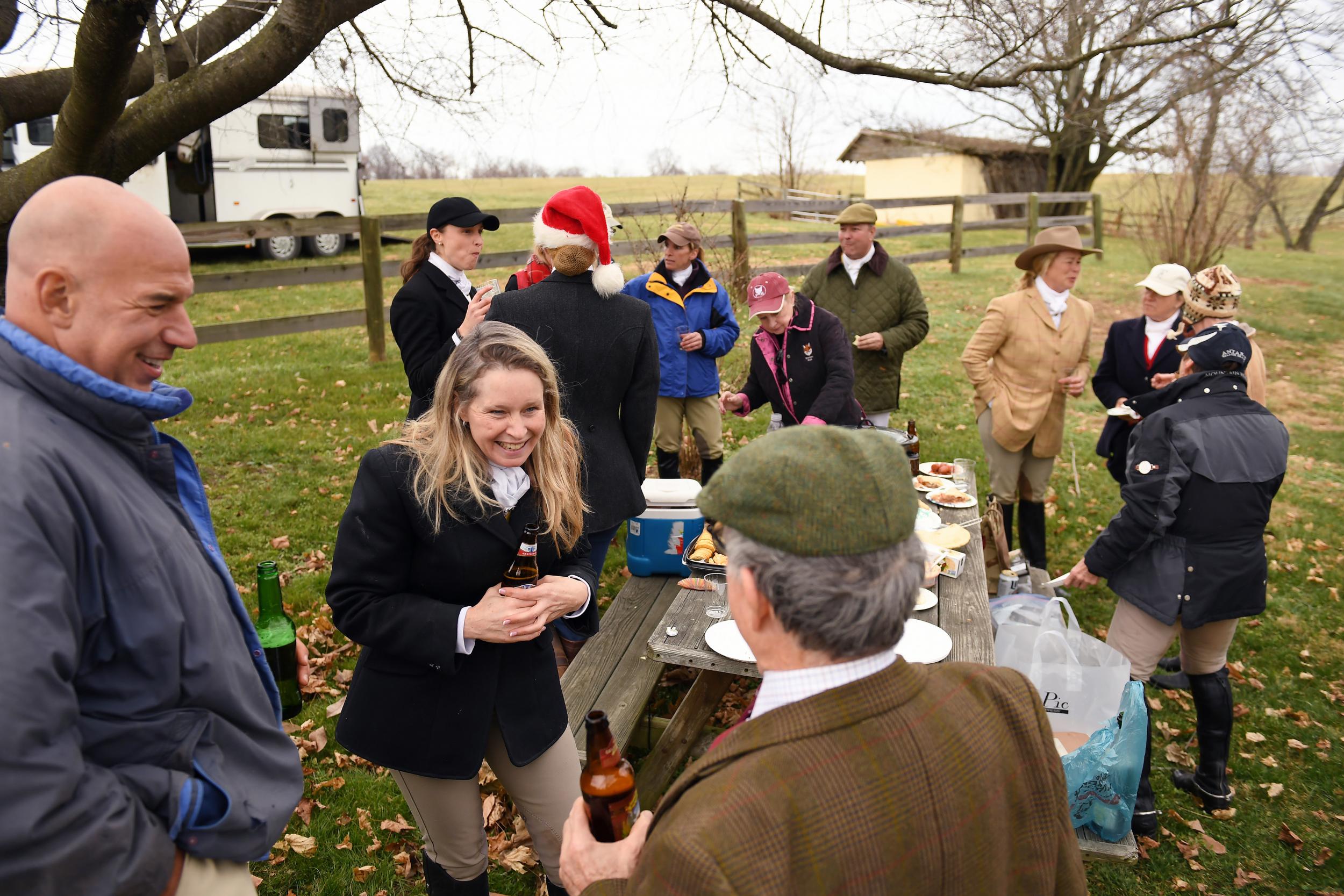
Much of this hierarchy is reflected in the formal codes of dress. Riders of sufficient experience and distinction are permitted to wear the hunt’s signature buttons and colours. Most notably, they can sport the scarlet riding jackets called pinks. The Masters of Foxhounds Association warns riders not to deviate from the activity’s strict chain of command. “A hunt is not a democracy. It is a dictatorship,” advises a recent issue of Covertside.
During my two mornings with the group, the Potomac Hunt seems a happy dictatorship under Kiely, who proves himself a keen tactician. During the first hunt, the fox crosses and recrosses Dry Seneca Creek, throwing the field off its scent. But Kiely guesses correctly that his quarry is heading for the surrounding woods and then a nearby farm. He casts his hounds in that direction and is rewarded with a fresh scent.
Kiely’s riders scramble to keep up with the hounds; I scramble to keep up with his riders. The hunt is typically divided into three fields: the first features the most able and daring riders, who jump, gallop and manoeuvre around obstacles to stay as close to the hounds as possible. The second field is slower, more social; they ride around many obstacles, not over them, and follow at a distance. And then there’s the third field – my field: the group that gets by without horses, hoping for a vicarious glimpse of the fun. In England and early America, the third field was traditionally made up of poorer villagers who followed on foot; at the Potomac Hunt, we get along in luxury SUVs.
At the end of my first morning, I catch up with the riders on the grounds of a plantation first owned by descendants of Martha Washington. By then, the fox has “gone to ground”: found itself a hole in the earth to hide in. In Great Britain, before a 2004 ban on fox hunting with dogs, such an outcome typically prompted the summoning of a terrier, who would lure the fox back to the surface so that a farmer could shoot it dead. In the United States, this rarely happens. For the Potomac Hunt, foxes are so scarce that participants not only spare their quarry, but they take active steps to keep it healthy. If a hunt member notices that a fox is looking mangy or sick, he’ll slip some antibiotics into raw chicken and leave it outside for the animal to eat. Brian Kiely gathers hounds
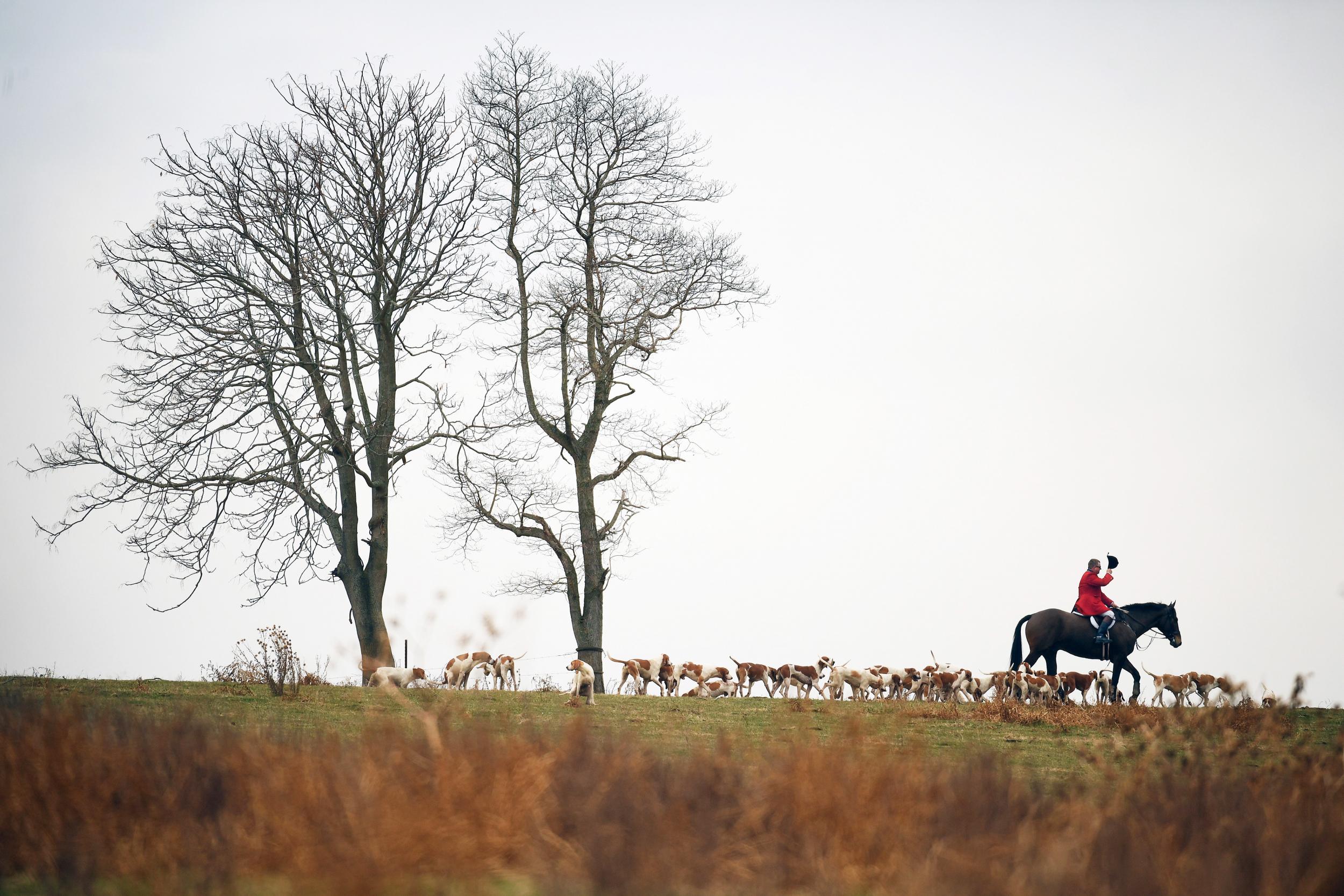
This intimate codependence exemplifies the slippery moral ground fox hunting occupies in the United States. I’m told repeatedly in my days with the hunt “that 99 per cent of foxes go to ground” and survive. Pity the unlucky 1 per cent that don’t and are instead torn apart by the pack of hounds. (Although the Masters of Foxhounds Association’s 2015 hunting code contends: “Death is instantaneous”, and “studies and reality confirm that hounds are a quick and humane method to dispatch an animal”.)
Even if there’s a 1 in 100 chance the fox will meet such a fate, is it morally permissible to chase it for fun? If you believe that animal suffering matters significantly, then fox hunting of any kind is an unequivocal wrong. That opinion was apparently shared by one of the bicyclists who recently called a Potomac Hunt member “a f***ing barbarian” as they crossed paths mid-hunt.
But does the fox – assuming it survives – suffer during a hunt? Science can provide only a partial answer. Speculating too vividly, and in too human terms, about the inner lives of animals is taboo among many academics. Benjamin Sacks, a biologist and fox expert at the University of California, Davis, has this to say about the impact of hunting on foxes: “Like any wild animal, a fox’s life revolves around getting their requisite needs fulfilled, and at the very least getting chased around all day gets in the way of their plans and prevents them from hunting and from provisioning their mate or their offspring.
“I suspect if you were to look at cortisol (stress hormone) levels, you’d find that, yeah, if you chase them, those go up. And if you’re both energetically stressed and hormonally stressed, that tends to lower your immune system, and so you’re more susceptible to all kinds of diseases, etc.” He declines, however, to offer an opinion on the morality of fox hunting itself.
Laypeople, then, are largely left to reach their own conclusions about how a fox might experience being hounded from point to point across the countryside. And the evidence suggests that American popular sentiment may be trending in one direction. In 2015, 60 per cent of Americans told Gallup that animals deserve “some rights”, while a third of respondents – the highest ever – said that animals should have the same rights as people. In England, Scotland and Wales, where legislation soon after the turn of the century banned fox hunting with dogs, opposition to the practice is near an all-time high. In a 2017 poll commissioned by the League Against Cruel Sports, some 85 per cent of the British public opposed lifting the current restrictions.
Perhaps most persuasive on the side of animal rights are a bevy of social media accounts like JuniperFoxx (Instagram followers: 2.1 million). Domesticated foxes like Juniper and her fellow pet, Fig, have been instrumental to the “dog-ification” of a species whose ancestors originally diverged from other canines some 10 million years ago. Watch as Juniper unwraps her Christmas presents, romps across her owners’ bed and fluffs her bushy tail. With every upload, an implicit plea: “How could you ever hunt me?”
Defenders of fox hunting are less sentimental about their quarry, if curiously anthropomorphic in tone. “I’m not going to say he’s enjoying it,” Fine explains. “It must be a nuisance to him, because all he wants to do is put food on his table and mate. But he’s a predator just like other animals, and he knows what the game is. I don’t think he feels terror if he’s not pressed too hard. It’s just a nuisance and he just takes it as he can, and if he can fool them, that’s it. That’s his job.”
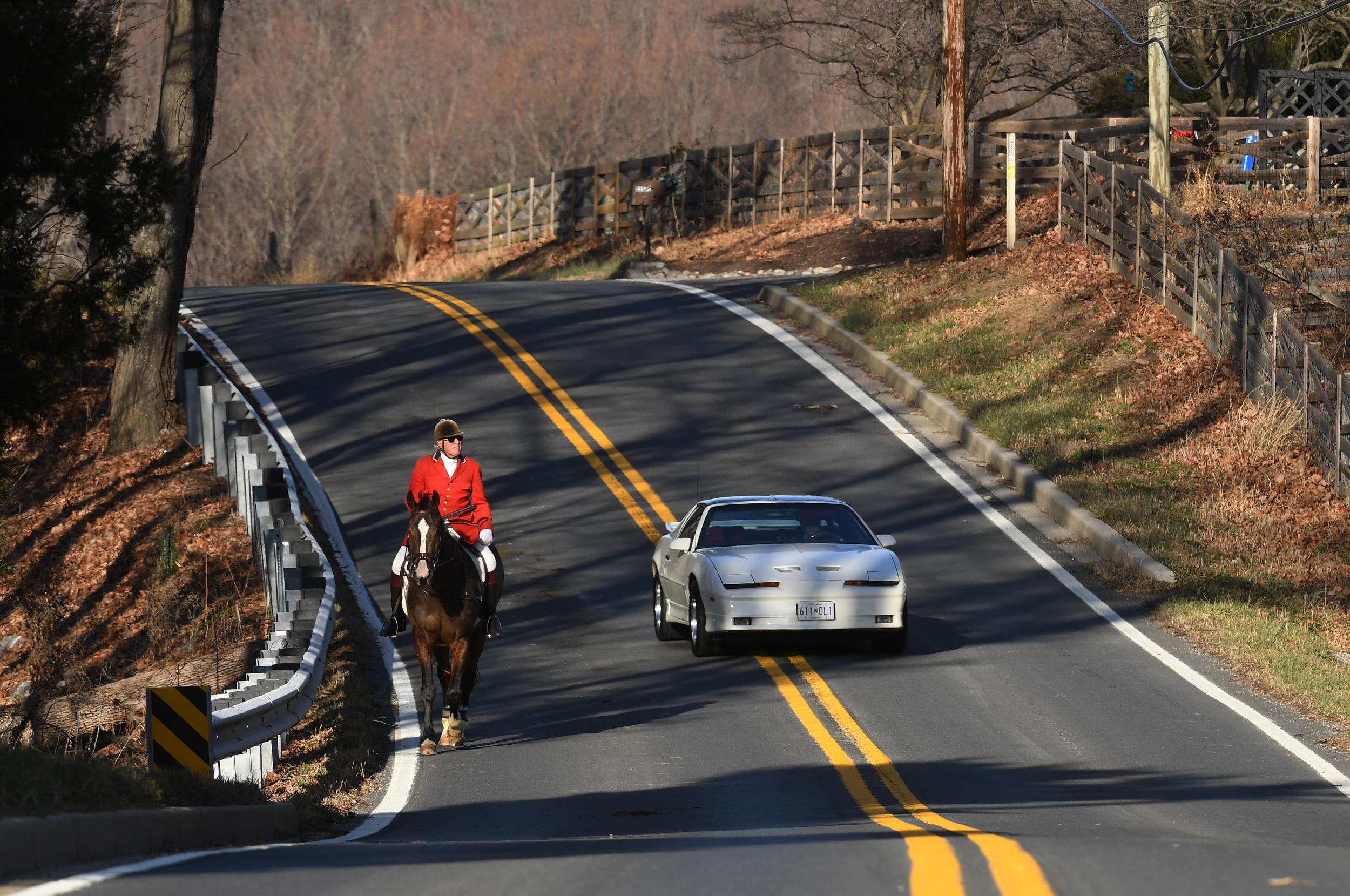
The morning of my second hunt in December is warm and sunny. But the night before, temperatures had dropped below freezing, leaving the open ground hard and slippery, “like oil on an ice-skating rink”, as one rider describes it. At an early juncture, one hunt participant is thrown from her horse and briefly knocked unconscious; she’s eventually taken to hospital by ambulance. (She has since recovered.) The rest of the field takes this event in remarkable stride: it turns out that such dangers go hand in hand with the chase. Two of the Potomac Hunt’s four masters have broken their necks; many more hunt members have cracked their ribs or injured their hips.
With the injured rider safely removed, the hunt resumes. Flushed from its covert, the fox leads the field racing across copse and pasture and into a swampy creek bed. As the group emergeds from the woods, Kiely once again predicts the path of his quarry and directs most of the field to jump over a fence and to climb a small hill. From there, the hunt is afforded a rare treat: the sight of the fox sprinting ahead, followed a few minutes later by the pack of hounds in noisome pursuit.
The most notable aspect of the second hunt is its large field – some 20 riders strong, including several young people. Brynn Miller, who at 7 years old is the youngest rider in the field, has been on at least 50 hunts with her horse, Rocky. “I like going fox hunting,” she says. “It’s open, it’s sort of like running around, you’re chasing and you’re running and you’re exercising your horse at the same time.”
It’s young riders like Brynn who will guide the future of fox hunting in America, whatever that may be. In Potomac, an effort is underway to look for the next generation of fox hunters. “We’re such a close-knit community, and I think if you don’t grow up in this community – ah, this is not going to sound good ... We haven’t always done a good job of reaching out beyond our community,” says Jennifer Queen, a member of the Potomac Hunt. To fix that, Queen started a juniors club three years ago that exposes local kids to the basics of the hunt.
Some of these juniors, attending a meeting at the hunt’s offices, explain what they love about the sport: “It’s a crazy rush, especially if you’re in the first field,” says Samantha Heller, 14. Rachael Kearn, 17, adds: “It’s such freedom, too, the way you can move with your horse, compared with when you’re in an arena for practice.” Heller describes a recent hunt she’d shared with Kearn: “We went down into a creek and just galloped flat out onto a straightaway. And we just looked at each other after and said, ‘That was the coolest thing that ever happened!’”
The hope is that these juniors will go out into their community and dispel scepticism about the hunt. Robert Queen, 17, recounts conversations he’s had with classmates: “People always say, ‘Oh my God, do you kill it?’”
“No, we don’t,” he recalls telling them. “We don’t have the ability to hunt and kill it, because we wouldn’t have a sport anymore!” As for the fox? “Honestly,” he says, “the ones that I see, they enjoy it.”
This kind of person-to-person diplomacy probably isn’t enough to stem the tide of history. But that doesn’t mean the hunts will vanish entirely. It’s hard to think of a sport more out of step with this era than the elite pastime of fox hunting, and yet it’s also hard to think of a sport more demonstrably, historically American. For all of our feints at egalitarianism, this has always been a place where those with means could retreat into the countryside and impose their will on land, man and beast.
© Washington Post
Join our commenting forum
Join thought-provoking conversations, follow other Independent readers and see their replies
Comments